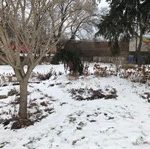Jan 20 2022
News from Kruse: January 2022
Shhh . . . Plants Sleeping! – by Keith Letsche The Kruse Garden in January: anything going on here?
The Kruse Garden in January: anything going on here?
Ever wondered what the plants in your garden are doing in the dead of winter? We know that of some of them—the annuals like petunias, lobelia, alyssum, marigolds and others bought at nurseries and greenhouses each spring or summer—are dead and gone and in the process of total decay. Others, like larkspur, which “come back” the following year, have in fact also died, but have reseeded themselves so that they look like they return in the spring.
But what about the true perennials—the daffodils, lilies, cone flower, and phlox? What do they do in the winter? Well, not much above ground, as is apparent from the withered and decaying stems and leaves. But the underground portions do not die but continue to live, and even to grow in some cases. This period in the perennial cycle is called “dormancy.” Its purpose is to protect the plant and conserve energy for regrowth in the spring.
Dormancy is triggered by the shorter amounts of daylight and cooling temperatures in the course of the fall. Cooling temperatures reduce the rate of a plant’s metabolism thus stymieing growth. Fluids are withdrawn from leaves, stems, and other above ground parts at the end of the growing season, so that the nutrients in the fluids are not lost but diverted to the roots, bulbs, tubers, or rhizomes to sustain them during winter. Come spring, the cycle is reversed by longer days and warming temperatures. And as everyone knows who has gotten behind in their springtime gardening, plants \really do jump up out of bed!
So, if you happen to go out in your garden this winter, remember, tip toe softly. Plants are sleeping!
No responses yet
Leave a Reply
You must be logged in to post a comment.
 - Membership
- Membership